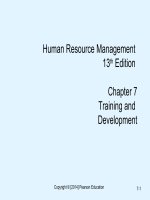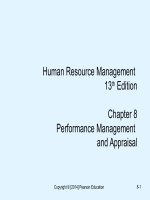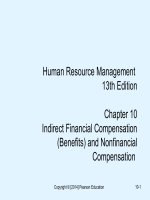Human resource 1e by denisi griffin chapter 06
Bạn đang xem bản rút gọn của tài liệu. Xem và tải ngay bản đầy đủ của tài liệu tại đây (533.27 KB, 25 trang )
Prepared by Joseph B. Mosca, Monmouth University and
© 2012 South-Western, Cengage Learning, Inc.
All rights reserved.
Marla M. Kameny, Baton Rouge Community College
PowerPoint Presentation Design by Charlie Cook
The University of West Alabama
Learning Objectives
After studying this chapter, you should be able to:
1. Discuss the role of ethics in HR decision making
2. Describe the concept of and organizational strategies
for rightsizing
3. Describe how to manage termination and retention
4. Describe the elements of voluntary turnover
5. Discuss key HR issues during mergers and
acquisitions
© 2012 South-Western, Cengage Learning, Inc. All rights reserved.
6–2
Ethics and HRM
• Ethics
Are an individual’s beliefs about what is right
and wrong, and good and bad.
Are formed by the societal context in which
people and organizations function.
• Ethical Behavior versus Legal Behavior
© 2012 South-Western, Cengage Learning, Inc. All rights reserved.
6–3
Rightsizing the Organization
The process of monitoring and
adjusting the composition of the
organization’s workforce to its
optimal size.
© 2012 South-Western, Cengage Learning, Inc. All rights reserved.
6–4
Temporary Solutions for Increased
Demand for Employees
Meeting
Meeting the
the Demand
Demand
for
for Employees
Employees
Overtime
Overtime
Employee
Employee
leasing
leasing
© 2012 South-Western, Cengage Learning, Inc. All rights reserved.
Part-time
Part-time
workers
workers
6–5
Dealing with a Decrease in Demand
for Employees
Adjusting
Adjusting for
for Fewer
Fewer
Employees
Employees
Reduce
Reduce
contingent
contingent
workforce
workforce
Retain
Retaincore
coreof
of
permanent
permanent
workers
workers
© 2012 South-Western, Cengage Learning, Inc. All rights reserved.
Utilize
Utilizestrategic
strategic
layoffs
layoffs
6–6
Justice in Organizations
Types
Types of
of Justice
Justice
Distributive
Distributive
justice
justice
Procedural
Procedural
justice
justice
© 2012 South-Western, Cengage Learning, Inc. All rights reserved.
Interactional
Interactional
justice
justice
6–7
Critical Dimensions of Procedural
Justice
© 2012 South-Western, Cengage Learning, Inc. All rights reserved.
6–8
Legal Issues in Layoffs
• Protecting Employee Rights
If layoffs result in disparate impact for
protected groups, legal actions can become
problematic.
Decisions to layoff more senior employees
can result in age discrimination suits.
Layoff decisions related to performance must
be based on a defensible performance
appraisal process.
© 2012 South-Western, Cengage Learning, Inc. All rights reserved.
6–9
Is Downsizing Effective?
• Stable Employers
Have changes in employment between plus and
minus 5%
• Employment Downsizers
Have employment declines of more than 5%; plant
and equipment declines of less than 5%
Have the lowest levels of return on assets and did
poorly on stock price.
• Asset Downsizers
Have employment declines of less than 5% but plant
and assets declines were at least 5% greater than
declines in unemployment
© 2012 South-Western, Cengage Learning, Inc. All rights reserved.
6–10
Beyond the Book:
Should Firms Use Downsizing When
Employees Are No Longer Needed?
• YES
It leads to quicker
decision making, more
precise accountability,
and harder-working
employees.
It can significantly
reduce a firm’s salary
expense when
unneeded employees
are terminated
© 2012 South-Western, Cengage Learning, Inc. All rights reserved.
• NO
Employees are needed
or they wouldn’t have
been hired in the first
place.
It is expensive because
firms must make
severance payments
and fund retirement
plans.
6–11
Progressive Discipline
• Punishment
Is following unacceptable behavior with some
type of negative consequences.
• Discipline
Is a system of rules and procedures for how
and when punishment is administered and
how severe the punishment.
© 2012 South-Western, Cengage Learning, Inc. All rights reserved.
6–12
Typical Disciplinary Problems
© 2012 South-Western, Cengage Learning, Inc. All rights reserved.
6–13
Progressive
Progressive
Disciplinary
Disciplinary
Plans
Plans
Verbal
Verbal
warning
warning
Written
Written
warning
warning
Suspension
Suspension
Termination
Termination
© 2012 South-Western, Cengage Learning, Inc. All rights reserved.
6–14
Employment-at-Will Doctrine
An employer can terminate any
employee at any time, for any
reason (good or bad), or for no
reason at all.
© 2012 South-Western, Cengage Learning, Inc. All rights reserved.
6–15
Exceptions to the Doctrine of Employment-atWill
© 2012 South-Western, Cengage Learning, Inc. All rights reserved.
6–16
Beyond the Book:
Preventing Employment-at-Will Problems
Make explicit statements that employment
is at-will
Write contracts specifying termination
procedures
Document performance or behavior
problems that may lead to discharge
© 2012 South-Western, Cengage Learning, Inc. All rights reserved.
6–17
Causes of Job Dissatisfaction
• Job Dissatisfaction
Is the feeling of being unhappy with one’s job.
Is a major cause of voluntary turnover
• Job Embeddedness
Refers to the fact that people will stay on their
jobs, even when they are unhappy and should
leave
Community ties or obligations keep the
employee on the job
© 2012 South-Western, Cengage Learning, Inc. All rights reserved.
6–18
Beyond the Book:
A Traditional Model of Quitting
© 2012 South-Western, Cengage Learning, Inc. All rights reserved.
6–19
A Model of
the
Turnover
Process
© 2012 South-Western, Cengage Learning, Inc. All rights reserved.
6–20
Causes
Causesof
ofJob
Job
Dissatisfaction
Dissatisfaction
Nature
Natureof
ofthe
the
work
work
Pay
Payand
and
benefits
benefits
© 2012 South-Western, Cengage Learning, Inc. All rights reserved.
Supervisors
Supervisorsand
and
co-workers
co-workers
6–21
The Effects of Job Dissatisfaction
• Organizational commitment
• Organizational citizenship behaviors
(OCBs)
© 2012 South-Western, Cengage Learning, Inc. All rights reserved.
6–22
Measuring and Monitoring
Job Satisfaction
• Primarily done through attitude surveys
distributed to employees
• Responses are used to track changes in
employees’ attitudes
© 2012 South-Western, Cengage Learning, Inc. All rights reserved.
6–23
Retention Strategies
• Realistic job previews (RJPs)
• Stock Options
© 2012 South-Western, Cengage Learning, Inc. All rights reserved.
6–24
Managing HR During
Mergers and Acquisitions
• HR manager plays a key role as
communicator because:
Employees are concerned about their jobs.
Speculation and rumors begin circulating.
An atmosphere of distrust emerges.
© 2012 South-Western, Cengage Learning, Inc. All rights reserved.
6–25









